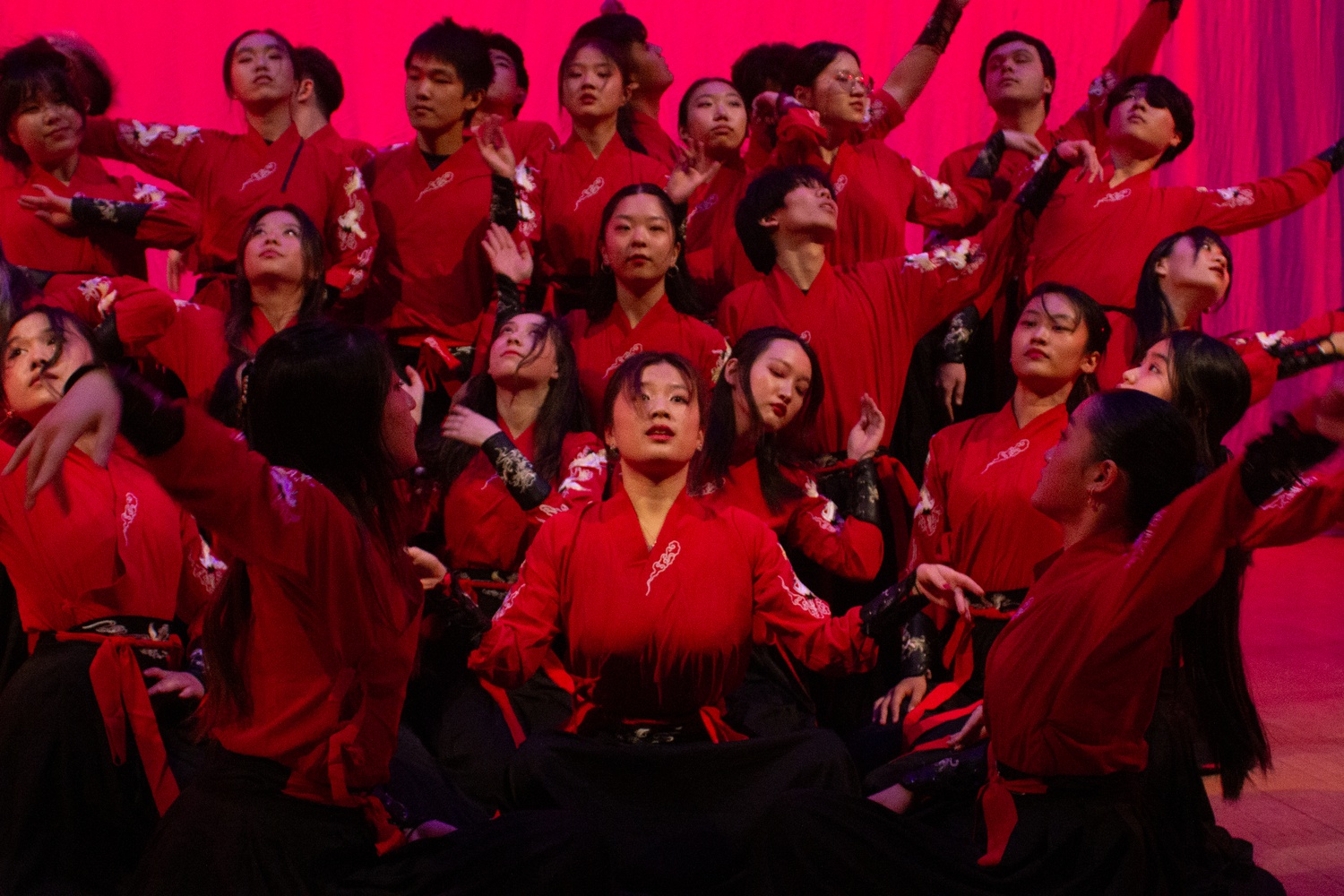
News
Progressive Labor Party Organizes Solidarity March With Harvard Yard Encampment

News
Encampment Protesters Briefly Raise 3 Palestinian Flags Over Harvard Yard

News
Mayor Wu Cancels Harvard Event After Affinity Groups Withdraw Over Emerson Encampment Police Response

News
Harvard Yard To Remain Indefinitely Closed Amid Encampment

News
HUPD Chief Says Harvard Yard Encampment is Peaceful, Defends Students’ Right to Protest
AADT’s ‘Horizon’ Review: Refreshing Fusion of Cultural Expression

As the lights dimmed and darkness eclipsed all corners of the stage, the packed seats of Lowell Lecture Hall exuded a palpable excitement. Intermittent cheering crescendoed into overwhelming jubilation as blue and gold light gleamed over the umbrellas of a coterie of dancers dressed in elegant, silk blue dresses.
On Nov. 1, Harvard’s Asian American Dance Troupe (AADT) performed their annual Fall semester dance show, “Horizon.” This year, “Horizon” debuted with an elegant, balletic demonstration of traditional Chinese umbrella dance. As the flute rang the air with an exceptional tranquility, dancers fluttered around the stage in a mesmerizing array of precision and musicality. Umbrellas jutted and rotated in unison, dancers moved in total harmony, and slow, graceful movements were juxtaposed with large, synchronized beats. While the flute disappeared slowly into the percussive strumming of the strings at the end of the movement, the stage eclipsed in a dark blue haze as the dancers raised their gaze and their umbrellas upwards to the ceiling.
The enchanting Chinese folk dance, titled “Flagship,” was merely a prelude to an evening that unfolded like a visual symphony woven together by a gamut of cultural influences and dance styles.
Following “Flagship” came “Chef’s Kiss,” dance covers of K-Pop group Seventeen’s “_WORLD” and “VERY NICE,” as well as of Stray Kids’ “God’s Menu.” The troupe’s groovy dance covers, filled with fancy footwork and sky-high jumps, emanated an infectious positivity. The set was characterized by a looser, freer choreography filled with vibrant explosions of movement. With the snappy chorus of “VERY NICE” still fresh in the air, red stage lights signaled the transition for Seventeen’s “God Menu.” Powerful, snappy, and coordinated sequences now took the place of free, individualized movements, and the dramatic change in choreography induced a burst of cheers from the audience.
The evening’s performances showcased a myriad of dance styles, and even a dynamic fusion of Bhangra with hip-hop from the guest performers Harvard Undergraduate Bhangra, who showcased the versatility of South Asian dance. These dancers used intricate footwork with the Sapp, an instrument native to Punjab, to create a fusion piece that was in every way Bhangra and nevertheless transcended cultural boundaries with its incorporation of American hip-hop.
In the performance immediately following Bhangra, the troupe’s seamless fusion of street style hip-hop and Afro dance with Korean music in “Junkyard” underscored the evening’s themes of unity and cultural celebration. The stage — once adorned with Chinese silk dresses and explosive K-pop covers — became a canvas on which each style contributed to the evening’s cross-cultural dialogue.
Immediately after “Junkyard” was the final piece of the night: “Beyond: Impermanence.” This piece was AADT’s original contemporary dance, which explored how people come to terms with change. A faint blue light signaled the start of the performance. Dancers moved in gentle fluid movements, with a raw and authentic vulnerability. The bleak costume design and delicate interplay between light and shadow worked together to produce an all-consuming melancholy. As the stage was further and further obscured, dancers disappeared one-by-one into the void until only one was left. Against the backdrop of Son Lux, Mitski, and David Byrne’s “This Is A Life,” the piece reflected the universal struggle of individuals trying to reconcile themselves with the impermanence inherent in living. “Beyond: Impermanence” concluded “Horizon” with a mesmerizing performance from the most advanced dancers in the troupe. The musicality, fluidity, and precision in every movement and technique was categorically masterful.
Every set within the 15 piece set list in “Horizon” added a unique dimension of cultural expression to the concert’s greater themes of cultural identity and cross-cultural dialogue. Diversified, entertaining, and profound, AADT’s Horizon succeeded in bridging together Asian American culture in one cohesive production.
Want to keep up with breaking news? Subscribe to our email newsletter.
